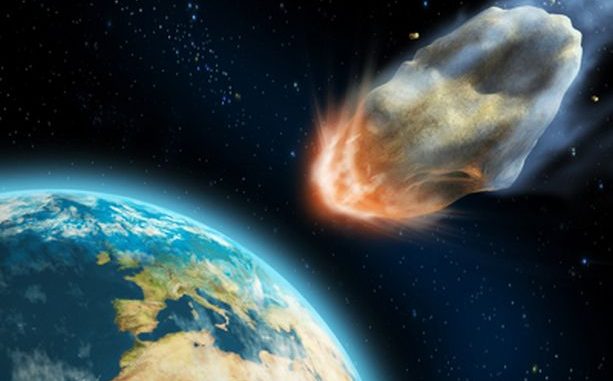
A piece of space rock one kilometre long brushed past the earth last night. The mega asteroid 1566 Icarus is getting closer to earth each time it passes by.
Scientists have warned that it might hit earth one day with devastating results. The huge rock could ravage a continent if it hit, causing wreckage across the hemisphere. According to Slooh astronomer Bob Berman: “It could destroy an area like the east coast of America and cause tsunamis and wreck a lot of the hemisphere. It would be catastrophic. It would not be earth destroying and wipe out the human race, but it would be very serious. If a half a mile object like Icarus did hit us it would be a very bad day indeed.”

BYPASS THE CENSORS
Sign up to get unfiltered news delivered straight to your inbox.
You can unsubscribe any time. By subscribing you agree to our Terms of Use
Latest Video
NASA has been monitoring the huge space rock since 1949. It described the 10pm flyby of the ‘close earth’ asteroid as potentially hazardous. Viewers were able to watch the asteroid flyby courtesy of the The Slooh telescope on the Canary Islands. Slooh’s internet channel showed Icarus pass the earth at a safe distance of 5million miles at around 70,000mph. But that means the space rock has got 5million miles closer to earth than the last time it approached the planet 19-years ago.
The Daily Express reports:
When it last passed by in 1996, it was a much more reassuring 10million miles away.
Mr Berman said: “In 1996 it was twice as far away, almost 10 million miles away and by that metric, this is very close. It has the potential, and it means some day it could hit us. It is one of a number we have to keep our eye on.”
Asked by a viewer through Twitter the potential result of a direct strike on earth, Mr Berman said it would be “catastrophic” after hitting at about 66,000 miles an hour – more than 28 times faster than the Moon’s orbit speed of 2,300mph.
He said: “It could destroy an area like the east coast of America and cause tsunamis and wreck a lot of the hemisphere. It would be catastrophic. It would not be earth destroying and wipe out the human race, but it would be very serious. If a half a mile object like Icarus did hit us it would be a very bad day indeed.”
But Mr Berman explained that it did not mean the next pass estimated in June 2043 would be another 5million miles closer, as the distances had been known to vary and it could pass further next time, and it may be thousands of years before it actually strikes.
But due to the uncertainty, he said systems to deal with a strike must be implemented.
He said: “Someday we will have something in place like an anti-comet, an anti-asteroid sentry system that can send a rocket out in time. Right now we don’t have that in place and the best thing we can do is watch these, monitor these and that is what we are doing.”
The asteroid flew by without incident at 21 times the distance between the Earth and our Moon, but in relation to the vast scale of the universe Icarus was considered to have “whistled past” our planet.
In 1967, in the months before it passed in 1968, a group of students used the asteroid to develop a plan to save the world in the event of a strike.
Slooh astronomer Will Gater said: “Close approaches like this one are always a reminder that our Solar System is a dynamic place, and that asteroids are thought to have played an important role in our past.”
NASA religiously monitors close asteroid fly-bys but does not believe we are in danger of actually being hit by space rock for several hundred years.
Over the past week www.Express.co.uk has revealed how asteroids the size of tower blocks, jumbo jets, and a car – all sizes that could devastate a city if they struck – have been monitored flying “close to Earth”.
Two more jumbo jet-sized asteroids are due after Icarus, one today and another tomorrow.
Another the size of a football stadium, at 225metres in length, is due to pass on Sunday.
World Asteroid Day, an event backed by Queen guitarist Brian May and TV astronomer Brian Cox takes place on June 30, to highlight the risk to our planet from cosmic rock strikes.
They argue NASA and other space agencies are not doing enough to prepare for a hit, and a system such as that described by Mr Berman should already be in place.
………………
Kurdistan Planetarium YouTube video:
Asteroid 1566, Icarus, discovered in 1949 by Walter Baade. is an Apollo asteroid, or near Earth asteroid, that at perihelion that comes closer to the Sun than Mercury,. Icarus was Classified as a Mercury/Venus/Mars crosser asteroid, Icarus does just that, crosses the orbits of Mercury, Venus and Mars. Icarus orbits the Sun in roughly 1.12 years and spends around 4-5 weeks in each sign.
It is named after Icarus of Greek mythology, who flew too close to the Sun.
Icarus makes a close approach to Earth at gaps of 9, 19, or 38 years. Rarely, it comes as close as 6.4 millon Km (4 million miles or 16 lunar distances), as it did on June 14, 1968. The last close approach was in 1996, at 15.1 millon Km, almost 40 times as far as the Moon. The next close approach will be June 16, 2015, at 8.1 millon Km (5 million miles).


